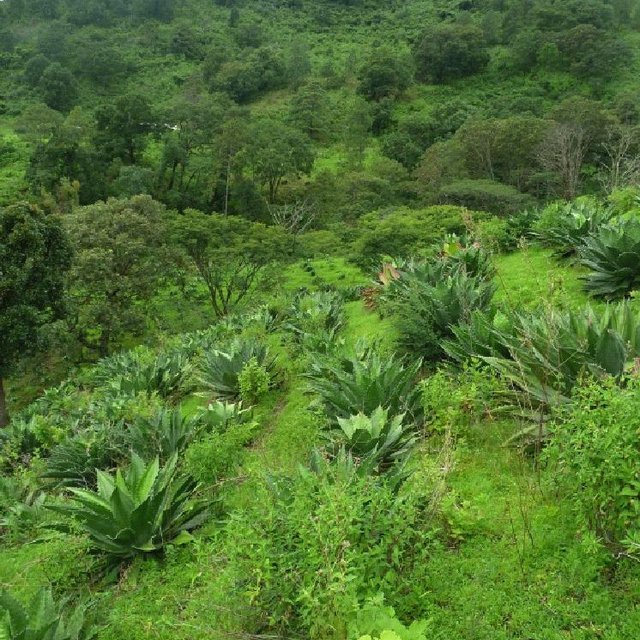



Rehabilitation of degraded land is achieved using native agave (Agave inaequidens), trees and/or fruit trees, shrubs and grasses to create, over the medium-term (7-10 years), sustainable production of a traditional alcoholic drink (mezcal) made from agave and/or cosmetic and medicinal products, and/or fibres and/or fodder for cattle and/or wood. Between the agave plants, native vegetation is managed or planted for use as food, fodder and/or medicinal products. Depending on the slope and the level of land degradation, continuous planted rows of agave provide a ’green’ barrier that controls soil erosion and runoff.
Purpose of the Technology: The main purpose is to achieve sustainable land rehabilitation while generating a high income for the farmer. This allows reducing the amount of livestock and overgrazing, which is the main cause of soil erosion in this region. The production of mezcal gives local farmers high incomes. Trees, shrubs and grasses for medicinal uses, food, and fodder are complements of agave production and are processed mainly by women, while agave harvesting is a male activity. As it is very attractive financially, farmers stay in the communities instead of emigrating to cities or abroad. Biodiversity is preserved and increased using native plants (agaves, trees, shrubs, grasses). These plant associations are effective at controlling plant pests and diseases. Turning eroded into productive soil sequesters carbon and increases water availability as a result of the new soil cover.
Establishment / maintenance activities and inputs: Unlike most agave, Agave inaequidens reproduces from seed, which requires harvesting the seeds from native plants in the fields. One plant generates 80,000 seeds with a 90% success rate of germination, which is enough to cover 25 ha of agave forestry plantations set up to control soil erosion. After harvesting seeds from native agaves, trees and shrubs, seedlings and small plants are raised in a greenhouse and nursery managed by the owners and tenants of the land in the first year. At the beginning of the rainy season, these are planted in plots protected from cattle grazing for at least the first two years after planting. The harvesting activity for trees, shrubs and grasses is done annually, but for the agaves only once every 7 to 12 years depending on the degree of soil degradation. Some months before harvesting, the flower from the stem has to be cut. The leaves are then cut and left in the plot while the 50 kg heart of the agave (“piña”) is removed. Mezcal is produced from the heart and requires an average of three weeks and at least two men to process 25 agave plants (1.5 tonnes), which produces about 300 litres of mezcal.
Natural / human environment: Poverty levels in the area are medium to high and the income from agriculture accounts for only 10 to 20% of the total family budget. People, therefore, do not have time to install soil erosion protection systems in the fields. Cattle graze freely everywhere and the number of animals is increasing annually, which also increases soil erosion. Locals know how to produce mezcal, but they prefer to buy it from other people who take wild plants from their lands to process them. The proximity of the site to the Michoacán of Ocampo state capital and the recognition of the designation of origin for mezcal by the authorities will enhance its value for future production.

Lieu: Morelia municipality, Mexico/Michoacán state, Mexique
Nbr de sites de la Technologie analysés:
Diffusion de la Technologie: répartie uniformément sur une zone (approx. 0,1-1 km2)
Dans des zones protégées en permanence ?:
Date de mise en oeuvre: il y a entre 10-50 ans
Type d'introduction













| Spécifiez les intrants | Unité | Quantité | Coûts par unité (mexican pesos) | Coût total par intrant (mexican pesos) | % des coût supporté par les exploitants des terres |
| Main d'œuvre | |||||
| Building of greenhouses | persons/day | 21,0 | 523,8095 | 11000,0 | |
| Seeding & maintaining in greenhouses | persons/3 months | 2,0 | 5000,0 | 10000,0 | |
| Installation of a nursery for agaves and trees | persons/day | 14,0 | 1071,4285 | 15000,0 | |
| Plant care and maintaining in nursery | persons/9months | 2,0 | 15000,0 | 30000,0 | |
| Matériel végétal | |||||
| Selection and collect Agave and tree seeds | plants | 5,0 | 100,0 | 500,0 | |
| Engrais et biocides | |||||
| Materials for plant care | months | 9,0 | 2777,7777777 | 25000,0 | |
| Matériaux de construction | |||||
| Materials for greenhouse | trees | 60000,0 | 0,056666666 | 3400,0 | |
| Materials for greenhouse | agave | 200000,0 | 0,035 | 7000,0 | |
| Materials for fences | m | 1500,0 | 2,4 | 3600,0 | |
| Materials for nurserys | trees | 60000,0 | 1,5 | 90000,0 | |
| Materials for nurserys | agaves | 200000,0 | 0,2 | 40000,0 | |
| Coût total de mise en place de la Technologie | 235'500.0 | ||||
| Coût total de mise en place de la Technologie en dollars américains (USD) | 18'115.38 | ||||
| Spécifiez les intrants | Unité | Quantité | Coûts par unité (mexican pesos) | Coût total par intrant (mexican pesos) | % des coût supporté par les exploitants des terres |
| Main d'œuvre | |||||
| Weeding around plants | persons/day | 10,0 | 160,0 | 1600,0 | 10,0 |
| Cutting the stalk before the harvest | persons/day | 15,0 | 150,0 | 2250,0 | 10,0 |
| Coût total d'entretien de la Technologie | 3'850.0 | ||||
| Coût total d'entretien de la Technologie en dollars américains (USD) | 296.15 | ||||
Reduction number of animals but improvement of meat production
Directly by plants , indirectly with the money earned, it is possible to buy medecinal products.
If producers sell their alcohol production abroad, no problems, if not problems!
Huge beneficts can create great conflicts!
It can be positive as well as negative (may induce corruption, violence)
The production of alcohol beverage (certified Mescal) from agaves, and/or in medicinal products, will generate very high Incomes for stakeholders. Life will change drastically. This allows the farmer's sons to stay in the community and work in the fields.